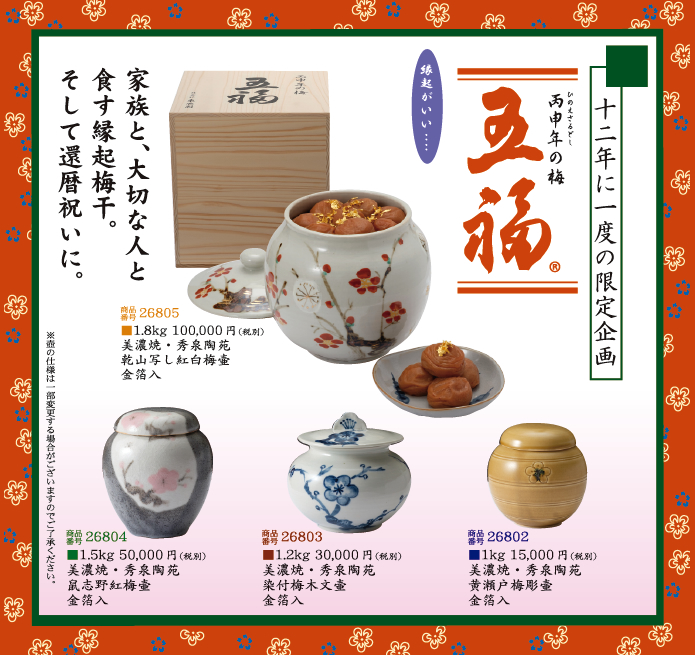
The pickled umeboshi plum is a common food in Japan, but can you guess what makes these plums special enough to warrant a US$850 price tag?
If you’ve ever had Japanese umeboshi, you’re not likely to forget how sour they are—just thinking about them is enough to make you salivate! The pickled fruit can be found at any supermarket in Japan and is commonly eaten with rice as a side dish or used as a rice-ball filling.
But as we’ve already hinted, the umeboshi we’re talking about here are no ordinary pickled plums. These are particularly “lucky” umeboshi that will be harvested and pickled in 2016, which happens to be the year of the monkey!
Before we go further, though, here’s a little more information on what exactly umeboshi is, for those of you unfamiliar with the food. Umeboshi, which literally means dried ume, is made from the fruit of the ume tree (Prunus mume), and while usually called a plum in English, the tree is actually more closely related to the apricot than the plum. Traditionally, the ripe ume fruit is picked in late May or early June each year, after which they’re packed in a barrel in layers of salt, and then weighed down with stones for one to two months while the juices are squeezed out of the fruit. The ume is then dried out in the sun for a few days, typically around July 20, when the weather is usually good and plenty of sun can be expected. Once the drying is complete, the ume is usually left to “mature” for periods ranging from a few months up to a few years, in order to let the flavor settle in. That’s a lot of time and effort for pickled plums!
▼ The process results in very sour-tasting, salty plums with a soft texture that goes surprisingly well with white rice:
But enough about plain regular umeboshi. The special umeboshi that we’re introducing here, called the “Plum from the year of the Fire Monkey — Five Luck (Hinoe Saru-doshi no Ume Gofuku)” is the masterful creation of Azuma Noen, a ume farm and producer of various ume products with a history of over 180 years, based in Wakayama Prefecture, which is located in the central main island and is also an area famous for quality umeboshi. In fact, umeboshi from present-day Wakayama used to be presented annually as a gift from the feudal lords of the area to the Tokugawa Shogunate, which ruled Japan during the Edo period (1603-1868).
Not only does the Five Luck umeboshi come from such an area, the fact that this year’s umeboshi will be made from ume harvested in the year of the monkey apparently makes them extra lucky, hence the 100,000 yen ($850) price tag for 1.8 kilograms (4 pounds) of pickled plum! According to ancient Japanese history/folklore, Emperor Murakami, who reigned as the 62nd Emperor in the 10th century, was cured of an illness when he drank tea mixed with umeboshi made in the year of the monkey, and since then it has become a custom to have umeoboshi mixed in tea, calling it Fukucha (lucky tea), at times of important celebrations including the New Year.
▼ The special umeboshi comes in a beautiful Mino ware ceramic pot decorated with ume flower patterns. And yes, that’s real gold leaf you see sprinkled on top!
The year of the monkey comes only every 12 years, so that’s how long you’re going to have to wait for this lucky product to become available again. And in case you were wondering, yes, 2016 is the year of the monkey, but in the Chinese sexagenary cycle, where each specific year is assigned a combination of one of the 10 heavenly stems (representing the five elements) and one of the 12 earthly branches (the animal years) in a rotation that comes around every 60 years, 2016 is also the year of the Fire Monkey, which is why “Fire” is included in the name of the umeboshi. The last part of the product name, “Five Luck”, refers to the five types of good luck mentioned in the ancient Chinese books Shu Jing and Hong Fan, namely: longevity, wealth, health and peace, good morals, and good death. Yup, they’ve certainly put a lot of thought into making these plums sound lucky.
You’ll need to be based in Japan, but if you’re interested in getting your hands on some of these special umeboshi from Azuma Noen, they’re now taking pre-orders on their online shop, Godaian. The actual umeboshi are expected to become available for shipping in November this year.
▼ In addition to the 1.8 kilogram package (shown on the upper left), the Five Luck umeboshi is also available in smaller amounts: 1.5 kilograms (3.3 pounds) for 50,000 yen ($425), 1.2 kilograms (2.6 pounds) for 30,000 yen ($255) and 1 kilogram (2.2 pounds) for 15,000 yen ($127).
May the lucky plums bring you lots of good fortune in 2016!
Source: Azuma Noen website, Azuma Noen online shop (Godaian) and @Press press release via Entabe
Photos: Azuma Noen online shop (Godaian)

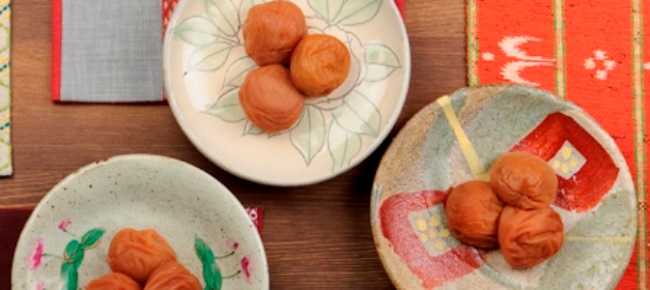
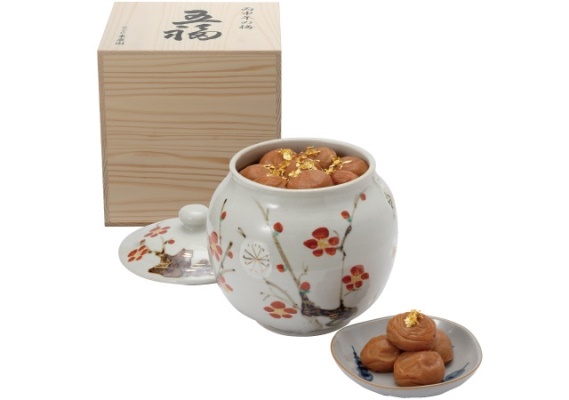
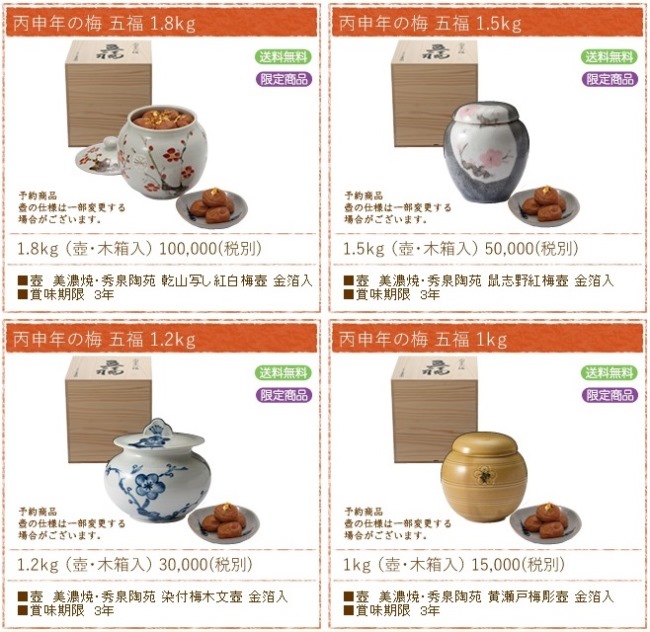
 Plum crazy Wakayama’s local take on Tabasco sauce is made with Japanese plums
Plum crazy Wakayama’s local take on Tabasco sauce is made with Japanese plums KitKat releases new Japanese plum flavor to celebrate Japan’s most beautiful winter flowers
KitKat releases new Japanese plum flavor to celebrate Japan’s most beautiful winter flowers Which Japanese convenience store sells the best onigiri rice balls?【Taste test】
Which Japanese convenience store sells the best onigiri rice balls?【Taste test】 Kyary Pamyu Pamyu bento sold for 10th anniversary tour
Kyary Pamyu Pamyu bento sold for 10th anniversary tour Sad news: 1,266 famous Tokyo plum trees get the axe to prevent spread of “plum pox”
Sad news: 1,266 famous Tokyo plum trees get the axe to prevent spread of “plum pox” Seaside scenery, history, and so many desserts on Yokohama’s Akai Kutsu【Japan Loop Buses】
Seaside scenery, history, and so many desserts on Yokohama’s Akai Kutsu【Japan Loop Buses】 Foreigner’s request for help in Tokyo makes us sad for the state of society
Foreigner’s request for help in Tokyo makes us sad for the state of society Should you add tartar sauce to Japanese curry rice? CoCo Ichi makes diners an unusual offer
Should you add tartar sauce to Japanese curry rice? CoCo Ichi makes diners an unusual offer Ghibli Park now selling “Grilled Frogs” from food cart in Valley of Witches
Ghibli Park now selling “Grilled Frogs” from food cart in Valley of Witches Japanese city loses residents’ personal data, which was on paper being transported on a windy day
Japanese city loses residents’ personal data, which was on paper being transported on a windy day Akihabara pop-up shop sells goods made by Japanese prison inmates
Akihabara pop-up shop sells goods made by Japanese prison inmates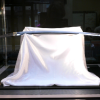 Amazing exhibition of Japan’s legendary “cursed katana” is going on right now【Photos】
Amazing exhibition of Japan’s legendary “cursed katana” is going on right now【Photos】 Yokohama restaurant serves fried axolotl, along with giant isopod, camel, and crocodile
Yokohama restaurant serves fried axolotl, along with giant isopod, camel, and crocodile We tried Korea’s way-too-big King Tonkatsu Burger at Lotteria 【Taste Test】
We tried Korea’s way-too-big King Tonkatsu Burger at Lotteria 【Taste Test】 Larger than life Doraemon doll will delight fans, terrify pets and small children
Larger than life Doraemon doll will delight fans, terrify pets and small children McDonald’s new Happy Meals offer up cute and practical Sanrio lifestyle goods
McDonald’s new Happy Meals offer up cute and practical Sanrio lifestyle goods Japanese ramen restaurants under pressure from new yen banknotes
Japanese ramen restaurants under pressure from new yen banknotes French Fries Bread in Tokyo’s Shibuya becomes a hit on social media
French Fries Bread in Tokyo’s Shibuya becomes a hit on social media Studio Ghibli releases new action figures featuring Nausicaä of the Valley of the Wind characters
Studio Ghibli releases new action figures featuring Nausicaä of the Valley of the Wind characters Red light district sushi restaurant in Tokyo shows us just how wrong we were about it
Red light district sushi restaurant in Tokyo shows us just how wrong we were about it New private rooms on Tokaido Shinkansen change the way we travel from Tokyo to Kyoto
New private rooms on Tokaido Shinkansen change the way we travel from Tokyo to Kyoto Tokyo Tsukiji fish market site to be redeveloped with 50,000-seat stadium, hotel, shopping center
Tokyo Tsukiji fish market site to be redeveloped with 50,000-seat stadium, hotel, shopping center Beautiful Ghibli sealing wax kits let you create accessories and elegant letter decorations【Pics】
Beautiful Ghibli sealing wax kits let you create accessories and elegant letter decorations【Pics】 Studio Ghibli releases Kiki’s Delivery Service chocolate cake pouches in Japan
Studio Ghibli releases Kiki’s Delivery Service chocolate cake pouches in Japan New definition of “Japanese whiskey” goes into effect to prevent fakes from fooling overseas buyers
New definition of “Japanese whiskey” goes into effect to prevent fakes from fooling overseas buyers Our Japanese reporter visits Costco in the U.S., finds super American and very Japanese things
Our Japanese reporter visits Costco in the U.S., finds super American and very Japanese things All-you-can-drink Starbucks and amazing views part of Tokyo’s new 170 meter-high sky lounge
All-you-can-drink Starbucks and amazing views part of Tokyo’s new 170 meter-high sky lounge More foreign tourists than ever before in history visited Japan last month
More foreign tourists than ever before in history visited Japan last month New Pokémon cakes let you eat your way through Pikachu and all the Eevee evolutions
New Pokémon cakes let you eat your way through Pikachu and all the Eevee evolutions Disney princesses get official manga makeovers for Manga Princess Cafe opening in Tokyo
Disney princesses get official manga makeovers for Manga Princess Cafe opening in Tokyo Sales of Japan’s most convenient train ticket/shopping payment cards suspended indefinitely
Sales of Japan’s most convenient train ticket/shopping payment cards suspended indefinitely Sold-out Studio Ghibli desktop humidifiers are back so Totoro can help you through the dry season
Sold-out Studio Ghibli desktop humidifiers are back so Totoro can help you through the dry season Japanese government to make first change to romanization spelling rules since the 1950s
Japanese government to make first change to romanization spelling rules since the 1950s Ghibli founders Toshio Suzuki and Hayao Miyazaki contribute to Japanese whisky Totoro label design
Ghibli founders Toshio Suzuki and Hayao Miyazaki contribute to Japanese whisky Totoro label design Doraemon found buried at sea as scene from 1993 anime becomes real life【Photos】
Doraemon found buried at sea as scene from 1993 anime becomes real life【Photos】 Tokyo’s most famous Starbucks is closed
Tokyo’s most famous Starbucks is closed One Piece characters’ nationalities revealed, but fans have mixed opinions
One Piece characters’ nationalities revealed, but fans have mixed opinions We asked a Uniqlo employee what four things we should buy and their suggestions didn’t disappoint
We asked a Uniqlo employee what four things we should buy and their suggestions didn’t disappoint Princesses, fruits, and blacksmiths: Study reveals the 30 most unusual family names in Japan
Princesses, fruits, and blacksmiths: Study reveals the 30 most unusual family names in Japan New Ume Sake Japanese Kit Kat features the flavour of traditional plum wine…with a twist
New Ume Sake Japanese Kit Kat features the flavour of traditional plum wine…with a twist Drinkable rice balls appear in Japan, allow you to chug the country’s favorite snack on the go
Drinkable rice balls appear in Japan, allow you to chug the country’s favorite snack on the go We tried a gourmet chocolate bento box worth 2,700 yen, and every bite was worth it
We tried a gourmet chocolate bento box worth 2,700 yen, and every bite was worth it These stunningly beautiful seasonal pink flowers from Japan are NOT cherry blossoms【Photos】
These stunningly beautiful seasonal pink flowers from Japan are NOT cherry blossoms【Photos】 What’s this Tibetan temple doing in the middle of Japan? We go to find out!
What’s this Tibetan temple doing in the middle of Japan? We go to find out! Kit Kat celebrates the Year of the Monkey with special Chinese Zodiac packages
Kit Kat celebrates the Year of the Monkey with special Chinese Zodiac packages Japanese bento serves up a slice of the samurai life in a special carry case
Japanese bento serves up a slice of the samurai life in a special carry case Japanese anime girl virtual YouTuber also speaks perfect English!【Video】
Japanese anime girl virtual YouTuber also speaks perfect English!【Video】 We taste makunouchi bento at four Japanese convenience store chains【Taste comparison】
We taste makunouchi bento at four Japanese convenience store chains【Taste comparison】 Do you know what this caterpillar-like food is? We had no idea!【Taste test】
Do you know what this caterpillar-like food is? We had no idea!【Taste test】 Does this egg timer from Japanese 100-yen store Daiso really work?
Does this egg timer from Japanese 100-yen store Daiso really work? McDonald’s creates a dream Japanese bento for April Fools’ Day
McDonald’s creates a dream Japanese bento for April Fools’ Day Bug hunt! Some areas offering rewards for alien beetles threatening Japan’s cherry blossoms
Bug hunt! Some areas offering rewards for alien beetles threatening Japan’s cherry blossoms Attack on sobriety: Round 2! This time, plum wine/juice with limited edition character labels
Attack on sobriety: Round 2! This time, plum wine/juice with limited edition character labels What makes this new Japanese convenience store chain better than 7-Eleven?
What makes this new Japanese convenience store chain better than 7-Eleven?
Leave a Reply